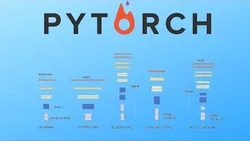
EfficientNet from scratch in Pytorch 
This tutorial provides an overview of the EfficientNet architecture and its implementation from scratch in Pytorch. It covers the imports, architecture configuration, implementation structure, CNNBlock, SqueezeExcitation, InvertedResidualBlock with Stochastic depth, and running a small test case. Finally, the tutorial concludes with a demonstration of the EfficientNet model. ▼
ADVERTISEMENT
Course Feature
![]() Cost:
Cost:
Free
![]() Provider:
Provider:
Youtube
![]() Certificate:
Certificate:
Paid Certification
![]() Language:
Language:
English
![]() Start Date:
Start Date:
On-Demand
Course Overview
❗The content presented here is sourced directly from Youtube platform. For comprehensive course details, including enrollment information, simply click on the 'Go to class' link on our website.
Updated in [February 21st, 2023]
- Introduction
- Imports
- Architecture config
- Implementation Structure
- CNNBlock
- SqueezeExcitation
- InvertedResidualBlock w. Stocasthic depth
- EfficientNet
- Running a small test case
- Ending
(Please note that we obtained the following content based on information that users may want to know, such as skills, applicable scenarios, future development, etc., combined with AI tools, and have been manually reviewed)
This course provides an overview of how to build an EfficientNet from scratch in Pytorch. It begins with an introduction to the necessary imports and architecture config. It then moves on to the implementation structure, including the CNNBlock, SqueezeExcitation, and InvertedResidualBlock with Stochastic depth. The course then covers the EfficientNet and how to run a small test case. It concludes with an ending.
[Applications]
After completing this course, students can apply the concepts learned to create their own custom EfficientNet models in Pytorch. They can also use the SqueezeExcitation and InvertedResidualBlock with Stochastic depth to create more efficient models. Additionally, they can use the EfficientNet model to run a small test case and evaluate the performance of their model.
[Career Paths]
1. Machine Learning Engineer: Machine Learning Engineers are responsible for developing and deploying machine learning models. They use a variety of tools and techniques to build, test, and deploy models. They also need to be able to interpret and explain the results of their models. The development of EfficientNet from scratch in Pytorch is a great way to gain the skills necessary to become a Machine Learning Engineer.
2. Data Scientist: Data Scientists use a variety of techniques to analyze data and develop insights. They need to be able to understand and interpret the results of their models. The development of EfficientNet from scratch in Pytorch is a great way to gain the skills necessary to become a Data Scientist.
3. Artificial Intelligence Engineer: Artificial Intelligence Engineers are responsible for developing and deploying AI systems. They need to be able to understand and interpret the results of their models. The development of EfficientNet from scratch in Pytorch is a great way to gain the skills necessary to become an Artificial Intelligence Engineer.
4. Deep Learning Engineer: Deep Learning Engineers are responsible for developing and deploying deep learning models. They need to be able to understand and interpret the results of their models. The development of EfficientNet from scratch in Pytorch is a great way to gain the skills necessary to become a Deep Learning Engineer.
[Education Paths]
1. Bachelor of Science in Computer Science: This degree path focuses on the fundamentals of computer science, such as programming, algorithms, data structures, and software engineering. It also covers topics such as artificial intelligence, machine learning, and computer graphics. This degree path is ideal for those interested in developing software applications and systems.
2. Master of Science in Artificial Intelligence: This degree path focuses on the development of intelligent systems and their applications. It covers topics such as natural language processing, computer vision, robotics, and machine learning. This degree path is ideal for those interested in developing intelligent systems and their applications.
3. Doctor of Philosophy in Machine Learning: This degree path focuses on the development of machine learning algorithms and their applications. It covers topics such as supervised and unsupervised learning, deep learning, reinforcement learning, and probabilistic graphical models. This degree path is ideal for those interested in developing machine learning algorithms and their applications.
4. Master of Science in Data Science: This degree path focuses on the development of data science techniques and their applications. It covers topics such as data mining, data visualization, predictive analytics, and big data. This degree path is ideal for those interested in developing data science techniques and their applications.
The development trends for these degree paths are focused on the use of artificial intelligence and machine learning to solve complex problems. Additionally, the use of big data and data science techniques are becoming increasingly important in the development of intelligent systems. Finally, the use of cloud computing and distributed systems are becoming more prevalent in the development of software applications and systems.
Course Provider

Provider Youtube's Stats at AZClass
Discussion and Reviews
0.0 (Based on 0 reviews)
Explore Similar Online Courses

MongoDB Aggregation Framework

iptables Complete Guide HackerSploit Linux Security

Python for Informatics: Exploring Information

Social Network Analysis

Introduction to Systematic Review and Meta-Analysis

The Analytics Edge

DCO042 - Python For Informatics

Causal Diagrams: Draw Your Assumptions Before Your Conclusions

Whole genome sequencing of bacterial genomes - tools and applications

PyTorch Tutorial - Neural Networks & GPU

Applied Deep Learning with PyTorch - Full Course


Start your review of EfficientNet from scratch in Pytorch